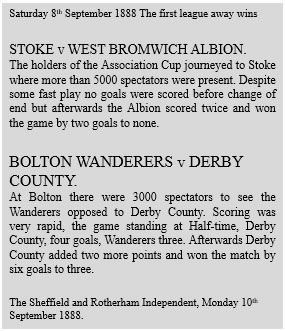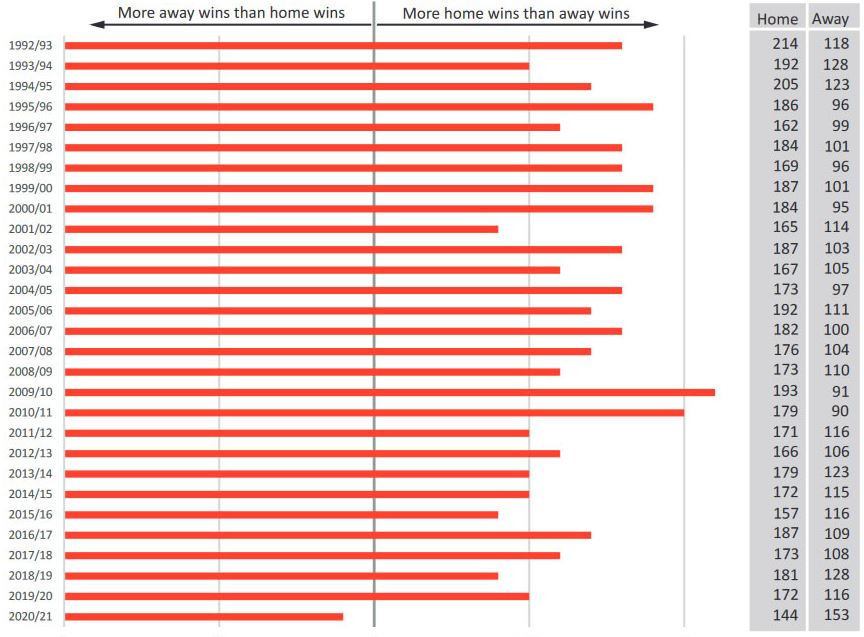No fans, no home advantage? For much of the Covid-19 pandemic so far, The English Premier League football has been played behind closed doors, without fans in the stands. Alan Jackson considers what effect this may have had on so-called “home advantage”
One of the things sports fans will have missed most during the Covid-19 pandemic is hearing the roar of the crowd in a packed stadium. Like many games the world over, during the 2020/21 season of the English Premier League, soccer matches were mostly played behind closed doors as part of national efforts to limit the spread of coronavirus.
For the players this will have felt like a very different experience. No home crowd to cheer them on. No plucky band of away supporters struggling in vain to drown out the boos and jeers of the opposition. However, the absence of fans due to the unique circumstances caused by Covid allows us to explore the effect supporters may have on the phenomenon known as “home advantage”.
Home advantage is a generally accepted fact in most sports and games. It is the increased chance of winning that a team or player has when playing on their home turf. A golfer playing on their usual course, for example, would be familiar with the length of the hols, the position of the bunkers, and the way the greens slope. International cricket teams prefer to play in their own country because the climatic conditions and the composition of the pitches in different countries can affect the behaviour of the ball. In Premier League football there are a number of factors that could potentially influence home advantage. Here we consider the two main ones to be (1) the stadium and (2) the cheering of the fans.
Let us set fans aside for the moment and concentrate on aspects of a stadium that might explain home advantage. It could be due to pitch differences. For example, in the 1980s several teams in the various English divisions installed synthetic playing surfaces. These were hard and unforgiving surfaces which meant that players were more prone to injury and the ball bounced in an unnatural way. Players who played on such surfaces regularly had an advantage over those who did not. But these surfaces have not been used in the English football leagues for about 30 years.
Differences in pitch size might also have an effect. Football Association rules state that the length of a football pitch must be between 90 metres and 120 metres, and the width between 45 metres and 90 metres. However, Premier League pitches are fairly consistent in size: half of them measure 105 metres by 68 metres. And there is a difference of only a few metres between the smallest and the largest pitch. It is therefore unlikely that a player would notice this.
Teams might also be at an advantage when playing at home because they do not need to travel long distances to a rival’s stadium – although Premier League players tend to travel in luxury and stay in plush hotels when playing far away from home, so it is not clear how much of a hardship this is. It appears, then, to be unlikely that stadium factors would contribute much, if anything, to home advantage.
This leaves the fans. But surely the performance of professional footballers would not be much affected by whether they are being cheered or not?
Home advantage in the Premier League
Before we consider this question further, we must first establish whether home advantage exists in the English Premier League. One way to do this is to compare the ratio of home and away wins for different teams over a number of seasons. This seems a fair approach as each of the 20 teams in the Premier League plays every other team once at home and once away (so, 38 games per team per season, and 380 games per season in total). The top-ranked teams would of course finish with more wins than the lower-ranked teams; but if home advantage does not exist then, at the end of a season and for each team, the number of home wins should be about the same as the number of away wins.
The English Premier League was set up on 20 February 1992. The bar plot shows the ratio of home wins to away wins from the first to the most recent season, while the table in the figure gives the number of home and away wins for each season.
The reason for home advantage
From the bar chart there appears to be clear evidence of home advantage. The number of home wins has been consistently larger than the number of away wins for all Premier League seasons, albeit with one exception: the 2020/21 season.
This brings us back to our motivating question. What is the reason for home advantage? Is it familiarity with the stadium, the support of the fans, or some combination of the two? Until the 2020/21 season it has not been possible to answer this question with any degree of certainty because fans and stadiums have gone hand-in-hand. But for most of last season fans were absent from grounds, or present in very imited numbers, giving rise to what might be considered a “natural experiment”. (We should note that there were some minor changes to the dates of fixtures during the 2020/21 season due to the pandemic, and some clubs did have players and staff off sick with Covid and other illnesses and injuries at various points. But, of course, clubs experience bouts of sickness and injury in all seasons.)
My argument is as follows. If stadiums are the main factor determining home advantage, then the home–away win ratio for the 2020/21 season should be similar to those of previous seasons because teams still played half their games at home and half their games away. (The average home–away win ratio for all Premier League seasons is 1.68.) If the support of fans is the main factor, then, because that factor has been largely absent, the number of home wins and away wins would be expected to be about equal. And this is indeed what we see in Figure 1: in the 2020/21 season there were 144 home wins and 153 away wins, giving a home–away win ratio of just over 0.9. This suggests that for the 2020/21 season, when fans had been absent or present only in very limited numbers, it did not seem to matter whether teams were playing at home or away, and that any possible stadium- related factors had no appreciable effect. In other words, there was no home advantage.
It will be interesting to see what happens in the 2021/22 season, when crowds are expected to be back in force.
Disclosure statement The author has been a supporter of Liverpool FC since 1963.
The article "No fans, no home advantage?" was originaly published by the Royal Statistical Society - July 2021 (nb behind a PayWall) and has been replicated here with kind permission of its author Alan Jackson.
 Link to all matches on the day
Link to all matches on the day
